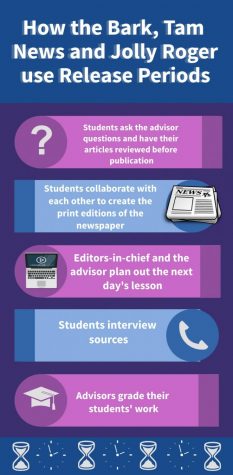Tam District journalism programs lose release periods due to budget cuts
June 17, 2020
As a result of proposed parcel tax Measure B failing to pass in March, the Tamalpais Union High School District (TUHSD) was forced to make the difficult decision on how it would make $1.1 million in cuts. Districtwide, it was determined that TEAM, the one year program offered by Tamiscal High School for juniors, would be suspended and release periods eliminated. These release periods, often called free periods, greatly impact the journalism publications of Redwood, Tamalpais, and Drake High Schools, as they have offered vital time to maintain the quality of each newspaper.
Bark students will lose face-to-face collaboration of the print edition, on demand edits from advisor Erin Schneider and access to equipment. Additionally, students will have greater difficulty creating the paper because they will now have to plan, sketch and layout the paper from home. At home, most students do not have access to software and computers that allow them to edit photos, lay out the paper and make infographics. With the release period, the Bark advisor had the ability to fact check and give in-depth edits to the writers. Now, Schneider will be teaching an English course during the release period when she used to spend time preparing for Bark-related activities.

The suspension of these class periods was a disappointment for many members of journalism programs across the district, especially Drake’s new journalism advisor, Jon Weller. After taking over the Jolly Roger less than a year ago, Weller said that he had high expectations for the program and had been working hard to transform it into something more exciting for students before the cuts were made.
“I spent pretty much my entire summer working on [the Jolly Roger],” Weller said. “When the release periods were taken off the table, I thought, ‘I just don’t know how I can proceed as a teacher with the goals that I’ve established for this group and keeping the changes in place that I worked so hard to do.’”
Weller, who also teaches three periods of an AP English class, found the release periods necessary so that he could finish his heavy grading load during the week and focus on creating lectures for the Jolly Roger on the weekends. Without this vital time, he believes the Jolly Roger’s quality could be diminished.
“My students aren’t going to be able to really do print because I can’t support that time,” Weller said. “In addition to that, I’m probably not going to have as much time for oversight with their writing. Without giving them feedback, it’s really going to land squarely on the shoulders of the editors.”
Drake junior Melissa Auchard, a current reporter for the Jolly Roger, said that the print editions have been a main source of inspiration and drive the student journalists to produce quality writing and illustrations.
“The print issue was such a strong source of passion for students,” Auchard said. “It was where the design students flourished and where we felt so proud and accomplished of our work because we got to see our classmates holding it and praising it.”
Auchard, who was recently informed she would be an editor-in-chief next year, believes that there are so many benefits to having students learn and practice journalism and was shocked that the programs are not being expanded.
“[The journalism program] helps boost confidence [in students]. One of my classmates was really timid because she had a lisp. When she joined the Jolly Roger and was in a leadership position this year, she became more confident in her ability to be a leader even though she struggles to speak sometimes. I also think that journalism is especially important for our community because student journalism provides a perspective that other news publications don’t have.”
In addition to Bark and the Jolly Roger, Tam High School’s journalism program, the Tam News, is dissatisfied with the cuts.
Tam junior Logan Little, who was recently chosen as editor-in-chief for the Tam News next year, does not believe a magazine can be produced and a curriculum can be taught during school hours. Cutting release periods will be devastating to how the Tam News currently functions.
“Release periods are a time that our journalism advisor gets to review everything,” Little said. “He’s being paid to review everything and basically work overtime to make sure that we don’t print something accidentally [inappropriate].”
Because the TUHSD journalism programs are student directed, Logan says there also are several benefits to the challenges students face that other courses cannot offer, adding to the overall losses the cuts of these release periods could initiate.
“I’m a completely different person from who I was freshman year,” Logan said. “I think a lot of that had to do with being forced to go out and interview a bunch of people and put together strong stories that dozens of people will read.”
In November, Marin voters have the opportunity to maintain the current parcel tax so that the quality of other programs within TUHSD are not diminished. As the impact of the first round of cuts has unfolded, many members of TUHSD, including student journalists, plead that people support the local schools.
“We still have students who are going to become tomorrow’s leaders and journalists, and they’re going to be making decisions on behalf of us old people,” Weller said. “If those decisions don’t come from a place of deep thought and critical thinking, I’m scared for that future.”







